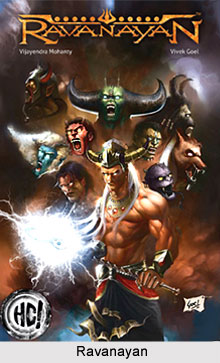 Ravanayan is an Indian comics series released in 10 parts in July 2011 by Holy Cow Entertainment. The subject matter of Ravanayan series in based on the Sanskrit epic Ramayana and depicts the character of Ravana as the main protagonist. The comics series is created by writer Vijayendra Mohanty, who is from Delhi and illustrated by artist Vivek Goel, who resides in Mumbai. The Indian comics series of Ravanayan will be divided into 12 chapters that will be released in over 10 issues. It is a fictional depiction of the Demon Lord Ravana, the antagonist of the ancient Hindu epic Ramayana.
Ravanayan is an Indian comics series released in 10 parts in July 2011 by Holy Cow Entertainment. The subject matter of Ravanayan series in based on the Sanskrit epic Ramayana and depicts the character of Ravana as the main protagonist. The comics series is created by writer Vijayendra Mohanty, who is from Delhi and illustrated by artist Vivek Goel, who resides in Mumbai. The Indian comics series of Ravanayan will be divided into 12 chapters that will be released in over 10 issues. It is a fictional depiction of the Demon Lord Ravana, the antagonist of the ancient Hindu epic Ramayana.
Content of Ravanayan
The plotline of the comics Ravanayan focuses on the life and adventures of Ravana. The story begins in the ancient times when a grand war was fought between Adharma and Dharma. The effects of the war were so devastating that it affected all the 3 worlds and fought, which led to the initiation of a new era. The rulers who won the wars were regarded as the new gods. But Ravanayan tells the story of the great king who lost. The new and exciting comic book series recounts the original Hindu epic composed by Valmiki, but emphasizes on the tales of the great king of Lanka, Ravana. He was believd to be the defeater of gods, conqueror of worlds and the leader of the rakshasa demons. The Indian comics creators Vivek Goel and Vijayendra Mohanty retell the eternal story and represent the inherent values of the original work of Ramayana to illustrate a story which is more complicated that a mere fight between the forces of good and evil.
Differences from Ramayana
The story of Ravanayan has several differences from the original work of Ramayana as the most striking feature of the comics series is that Ravana is depicted as the central character in the story, instead of Lord Rama, and there are many other differences as well. Vivek Goel and Vijayendra Mohanty have portrayed Ravana as an honourable King and ruler as the kingdom of Lanka and his peasants prospered and thrived during his rule, hence it was renowned as Golden Lanka. The character design of Ravana has also been envisioned and imagined in a brand new way. In the series, Ravana is portrayed as an attractive and strong young man with long white hair. The lead character does not possess the traditional moustache and is shown as clean shaven. Most of the other characters have been re-imagined as well.
Further more, Ravana has not been depicted with the conventional ten demonic heads, as the popular belief. The creators have rather elaborated on each of the ten characteristics and qualities that the heads represented. The Indian comics of Ravanayan focuses more on the characters related to the King of Lanka, instead of the important characters shown in Ramayana, who are mostly linked with Rama, the prince of Ayodha. Some of the chapters in the work also discusses about the inner and hidden personalities of the 3 royal brothers, namely Ravana, Vibhishana and Kumbhakarna.
The publishers, Holy Cow Entertainment, have already launched the first three issues of the series where the story takes a twist when Ravana asks for immortality from Lord Brahma. This modern tale of Ravana and his life takes the readers on an captivating journey and conveys the inner meanings of dharma and adharma, right and wrong.



















